VO2 Max – If you have been a part of the running community for any time, you have probably heard about VO2 Max. Some runners will post pictures of their Garmin watch’s VO2 Max readings on social media and, in many cases, obsess over their score.
But is VO2 Max that important to runners?
In this article, I discuss what VO2 Max is and what you should know about it. I’ll discuss how VO2 Max is measured, how it relates to our fitness level and running performance, and how VO2 Max differs between men and women as we age. Finally, I will share some ways you can improve your VO2 max score for better running performance.
So let’s start by defining what is VO2 max.
What is VO2 Max?
VO2 Max is a measurement that helps quantify our body’s ability to utilize the oxygen in the air we breathe most effectively. VO2 Max testing is considered the gold standard for evaluating someone’s aerobic and cardiovascular fitness.
More specifically, VO2 Max is used for gauging your cardiorespiratory fitness level at its upper limit.
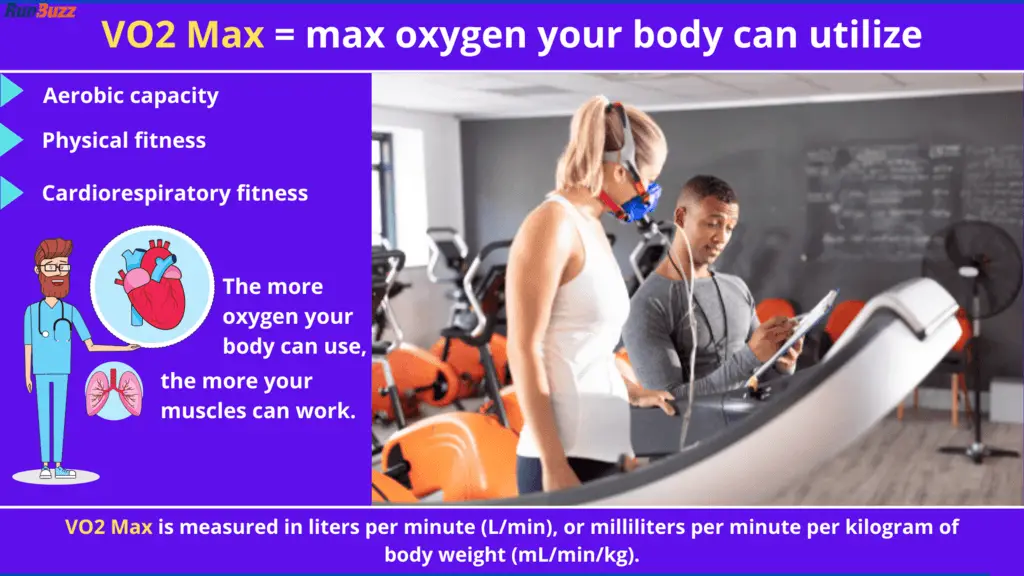
When you run at an intensity level above your VO2 Max, your body will develop what is known as oxygen debt. When your body is in an oxygen deficit, it isn’t easy to maintain your speed. In other words, you fizzle out fast.
Since VO2 Max measures our body’s upper limit of cardiovascular fitness and its maximum oxygen uptake, it makes a great metric that correlates to our overall fitness level and aerobic endurance. The better our VO2 Max is, the better it performs, especially its ability to sustain our speed over distance.
What Does VO2 Max Mean?
V – Stands for Volume. This is the maximal amount of oxygen you intake during exercise.
O2 – Stands for Oxygen. Oxygen is a critical component in energy conversion.
Max – Stands for Maximal oxygen or simply the maximum amount we can uptake per one minute of exercise.
Benefits of Improving Your VO2 Max
VO2 Max isn’t just about how much oxygen you breathe. Improving our VO2 Max has several benefits and consists of the following:
Improved Lung Capacity – When we run and train properly, our lung capacity improves. This means we can pump more oxygenated blood to our muscle cells which results in better performance. Additionally, the more efficiently we train, the more capillaries we create, which improves the delivery of oxygenated blood to our cells.
Improved Energy Efficiency – The more efficiently we can convert oxygen and muscle glycogen into energy, the faster we can run. Muscle glycogen is stored sugars that result from eating carbohydrates.
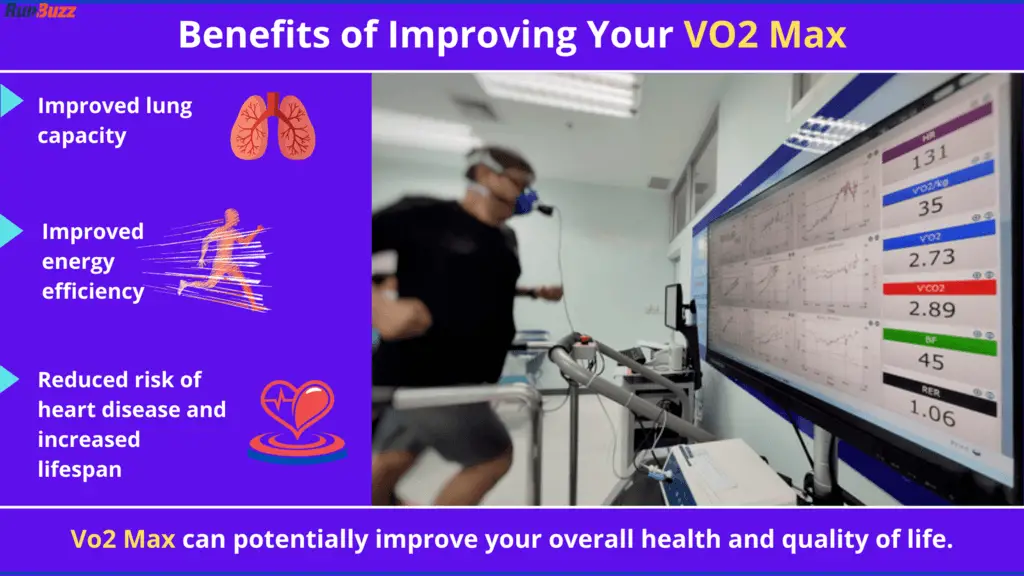
How is VO2 Max Measured?
VO2 Max is measured in liters per minute (L/min), or milliliters per minute per kilogram of body weight (mL/min/kg).
This represents the maximum amount of oxygen our body can uptake, pump through our heart, deliver to our muscles, and used by our mitochondria in our cells. The mitochondria are little energy factories that use oxygen alongside our body’s fuel to generate the energy we use to run.
Oxygen is a critical component in this process for all runs greater than 200-400 meters. Therefore the higher our VO2 Max score is, the more oxygen is available in this process.
While some running watches can estimate your VO2 max based on analyzing your past runs, the most accurate way to calculate your VO2 max involves formal lab testing. Other indirect estimation techniques include the Cooper 12 Minute Run Test or the Bruce Protocol Treadmill Test.
VO2 Max Lab Testing
As I mentioned earlier, getting accurate VO2 Max scores requires lab testing. Unfortunately, this makes accurate measuring hard to achieve for the average runner like you and me. In as little as 11-12 minutes, you can learn what your VO2 Max value is along with other useful information.
In most mid-size to large cities, labs are found near universities or large medical facilities. The test is conducted using a clinician or medical professional.
- The average price for a VO2 Max test where I live is around $100 to $150 for a simple VO2 treadmill test. Add in other tests like lactate threshold and caloric needs analysis, and that price can jump up another $100 to $200.
If you want to see a VO2 max test, check out this video:
During the test, you will run on a treadmill or stationary bike, and the clinician will systematically increase your speed and intensity. If you are a runner, you should seek out a treadmill test whenever possible as it more closely matches your running for obvious reasons.
You will also wear an oxygen mask throughout the duration of the test that measures the amount of oxygen you breathe in to measure your maximal oxygen uptake and the amount of carbon dioxide you are exhaling.
You may likely be hooked up to other equipment like a heart rate monitor and pulse ox machine as this information is useful and part of the calculation or other tests that may be conducted simultaneously.
Other tests that a lab may offer:
- Lactate threshold (LT) testing
- Calculating maximum heart rate (HR max)
- Caloric need estimation
This data can accurately set heart rate zones for heart rate training if that is something you are interested in.
In the case of lactate threshold testing, you will experience a small blood draw during the test to test your lactate accumulation levels. For some testing facilities, this is an optional but useful test for measuring your aerobic fitness. Lactate threshold and VO2 Max are useful measurements for determining training and race paces and measuring performance for those who want to improve speed and endurance.
While a VO2 Max test is not the most pleasant experience, it can be a valuable metric to track your training progress. During the test, you will be pushed hard, with increases in intensity about every one minute or so. For some, the mask can feel a little
The benefit of getting a VO2 Max test before starting 5k, half marathon, or marathon training is that you can measure the effectiveness of your training by getting a test again after your race.
How to Estimate Your VO2 Max Using the Cooper 12-Minute Run Test
If lab testing is not an option for you, there are other ways to estimate your VO2 max.
In 1968, Dr. Kenneth Cooper, MD, developed a 12-minute run fitness test to estimate VO2 Max for the military. Just over 50 years later, the test is still used today as a quick way to estimate your VO2 Max.
Dr. Cooper observed a high correlation between how far a person could run in 12 minutes and their VO2 Max value.
The 12-Minute Cooper Run Test
To conduct the 12-minute Cooper run test, you will need a stopwatch or one of my recommended GPS running watches to measure the time and distance you can run or walk over a 12 minute period.
Because this test can be strenuous, it is important to be physically fit and have your physician’s clearance before taking on the test. Also, be sure to warm-up for 10-15 minutes before starting your test.
Once the test starts, run and/or walk as far as you can in 12 minutes. Record the distance.
To calculate your VO2 Max:
- Kilometers: VO2max = (22.351 x the kilometers you ran) – 11.288
- Miles: VO2max = (35.97 x the miles you ran) – 11.29
Note: If taking the test on a treadmill, set your treadmill elevation to 1% to best simulate outdoor running.
There is also a Cooper Run Test calculator, which you can find here if you prefer to have your score calculated for you.
VO2 Max Charts for Cooper Fitness Run Test – Males
If you want to see how your score compares to others, you can use the following charts:
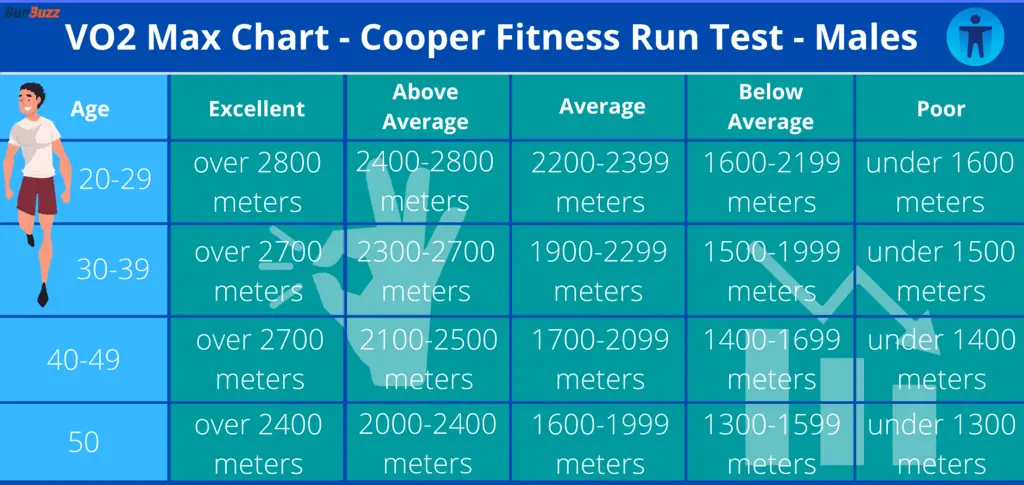
VO2 Max Charts for Cooper Fitness Run Test – Females
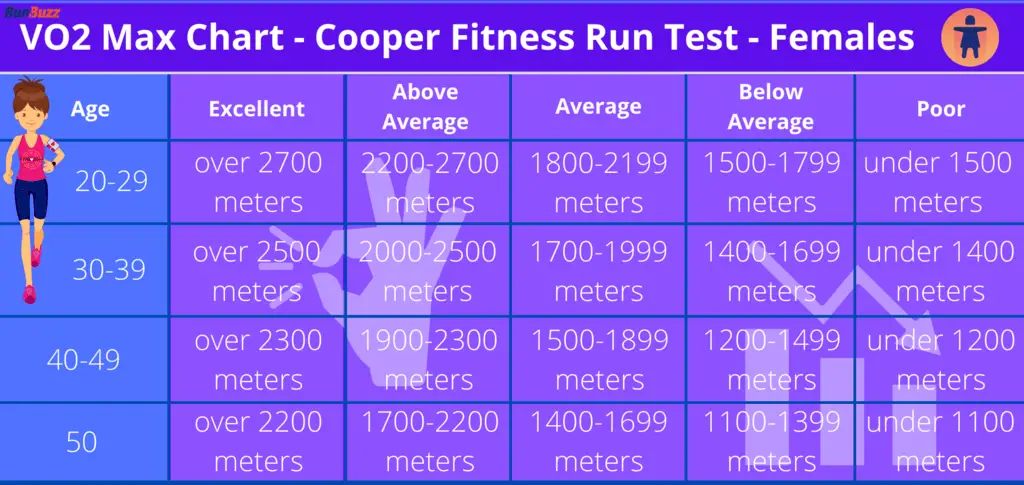
How to Estimate Your VO2 Max Using the Bruce Protocol Treadmill Test
Another VO2 Max test is the Bruce Protocol Treadmill Test. This test is strenuous and ideally should be conducted under expert supervision. It is also known as a stress test to test exercise tolerance. Robert Bruce created it in 1963 as a way to assess cardiac patients he suspected has heart disease.
The Bruce Protocol Test is conducted on a treadmill, and the runner faces increased speed and inclines every three minutes. The total duration is recorded then run through the following formula:
- Men: Estimated VO2 max = 14.8 – (1.379 x T) + (0.451 x T²) – (0.012 x T³)
- Women: Estimated VO2 max = 4.38 x T – 3.9
- T = total time on the treadmill.
Bruce Protocol Test Stages
Stage 1: 1.7 mph at 10% incline
Stage 2: 2.5 mph at 12% incline
Stage 3: 3.4 mph at 14% incline
Stage 4: 4.2 mph at 16% incline
Stage 5: 5.0 mph at 18% incline
Stage 6: 5.5 mph at 20% incline
Stage 7: 5.0 mph at 22% incline
Bruce Protocol Norms Chart
Once you know your total time and run it through the formula above, you can see how you compare to other men and women. Keep in mind that these are estimations, and a lot of factors play into each person’s scores.
VO2 Max Norms For Males
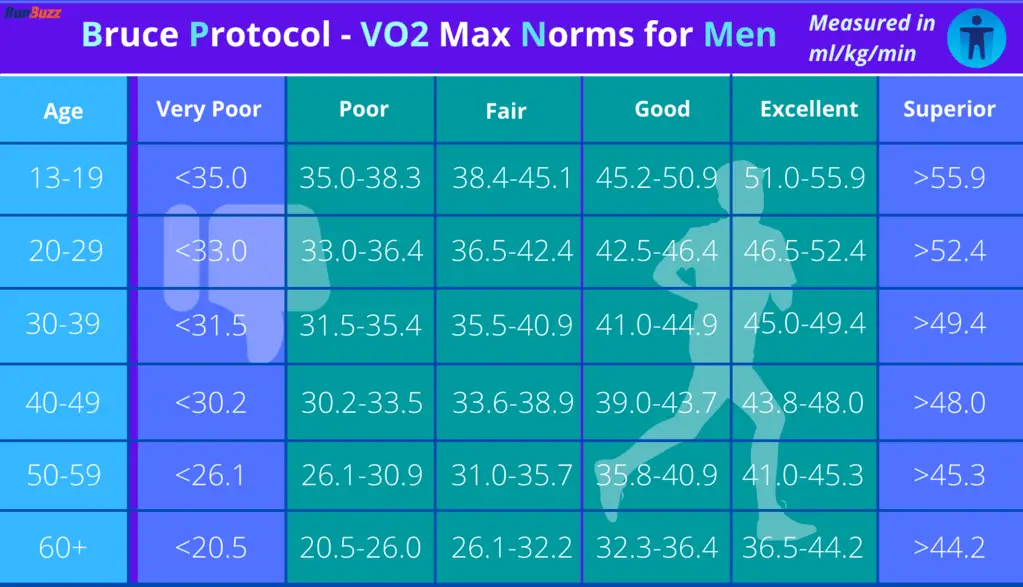
VO2 Max Norms For Females
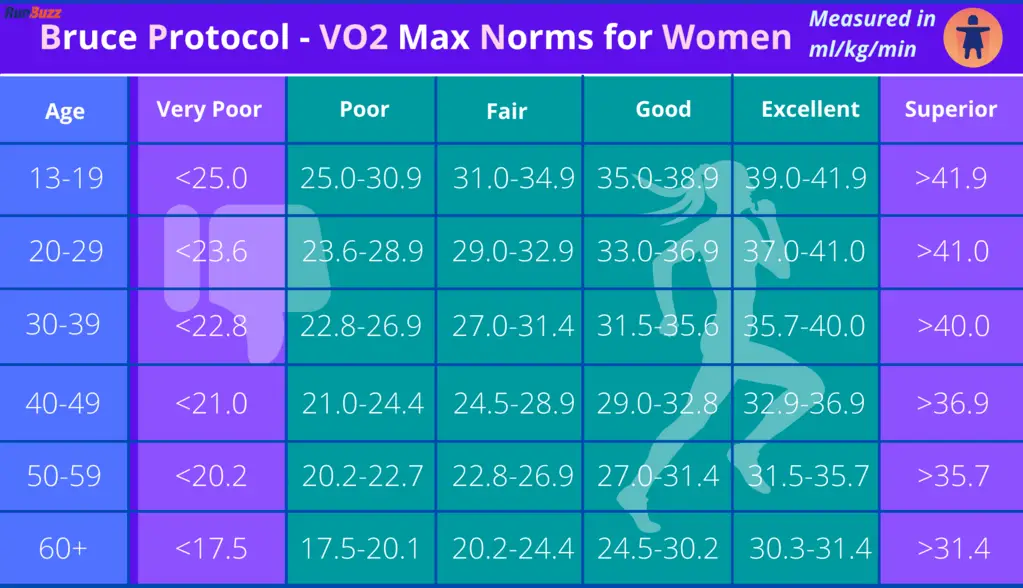
The Impact of Age on Your VO2 Max
Your age can impact your VO2 Max. Generally speaking, your VO2 Max tends to peak in your 20’s and 30’s before declining approximately 10-12% per decade. However, like many things, the impact of age on your VO2 max isn’t this simple.
For example, if you have lived a sedentary lifestyle in your 20’s and 30’s and don’t start running until you are in your 40’s or 50’s, you can expect improvement in your VO2 Max for several years before you reach your peak and decline thereafter. Certainly, your age impacts your potential, but for most runners, our fitness age also matters.
Unlike your actual age, your fitness age is based on how long you have been making fitness a part of your lifestyle and the improvements you make, and how your VO2 (and other metrics) improve as your fitness levels improve. Some experts also use comparison with other runners your age to help determine your fitness age.
So while you may be 45 years old, your fitness age may actually be 38 because of your VO2 Max, height, weight, gender, age, genetics and exercise frequency, and a host of other factors.
So if you are a late start runner, rest assured you can improve for several years to come!
What Is a Good VO2 Max for Men and Women?
Because of differences in body size, body composition, blood volume, muscle mass, and amount of hemoglobin in the blood, VO2 max in women is generally about 20% lower than the VO2 max of males. Overall, health and age apply to either sex.
However, this is just a rough estimate and what we can’t forget about is individualization.
With less cardiac output than men and lower hemoglobin levels, women’s blood can carry less oxygen on average. Oxygen binds to the hemoglobin in our red blood cells. With less hemoglobin, this means that less oxygen makes it to the muscle.
Additionally, women tend to have more body fat than men, which means that more blood is being delivered to non-muscle cells.
Generally speaking, a good VO2 Max for untrained women in their 30’s to mid-’40s tends to be around 31 ml oxygen/kg of body weight per minute, while untrained men tend to fall in the 42 ml oxygen/kg of body weight per minute.
For a fit person in that same range, the average VO2 Max is around 45 ml oxygen/kg of body weight per minute and 51 ml oxygen/kg of body weight for males.
For those of you who consider yourself a serious athlete, your V02 Max may be considerably higher.
Most female competitive and semi-competitive athletes often see VO2 Max ranges in the 60-85 ml range, while competitive and semi-competitive male athletes see numbers in the 70-85 ml range.
VO2 Max Chart for Male Runners
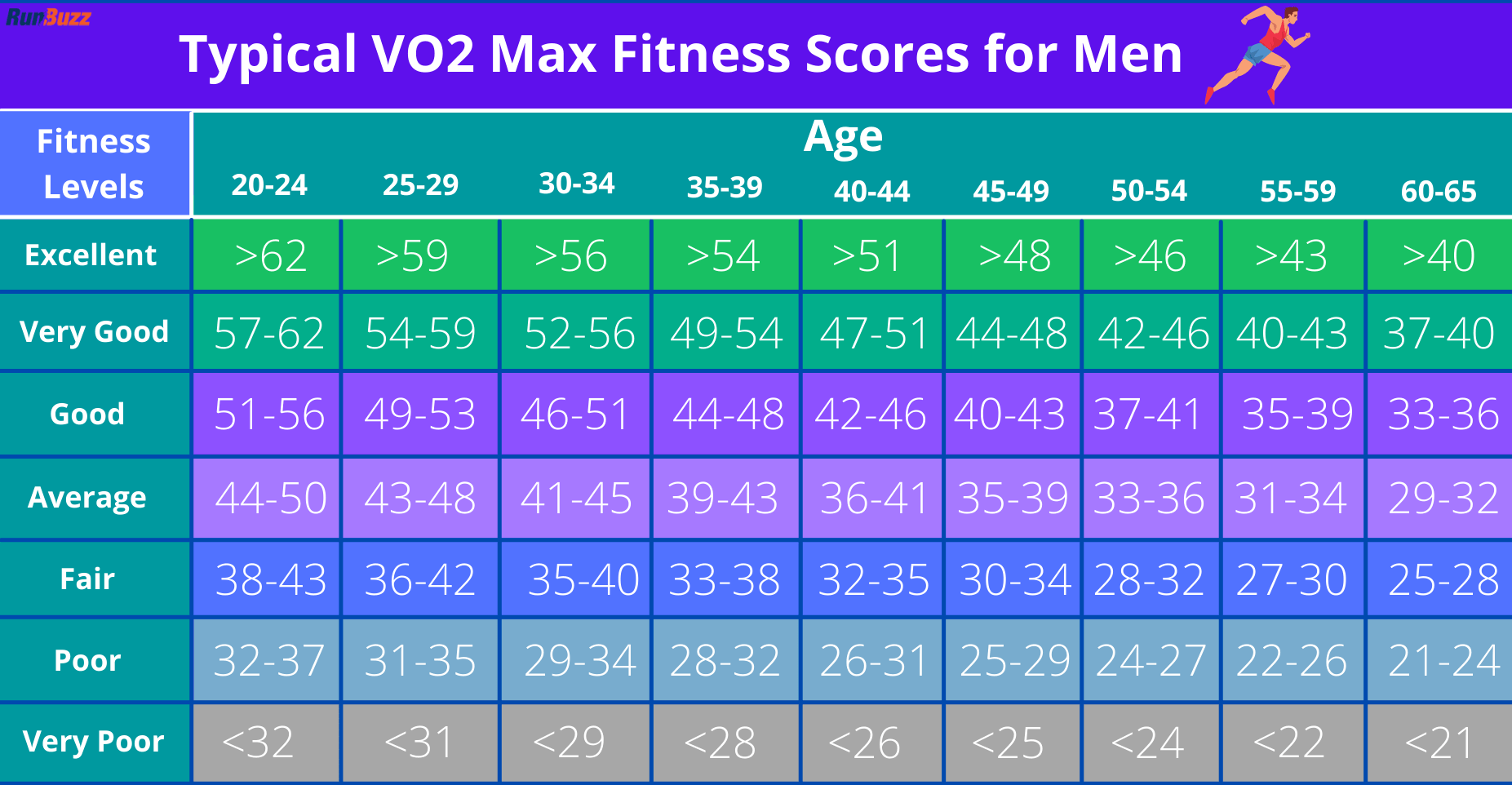
VO2 Max Chart for Female Runners
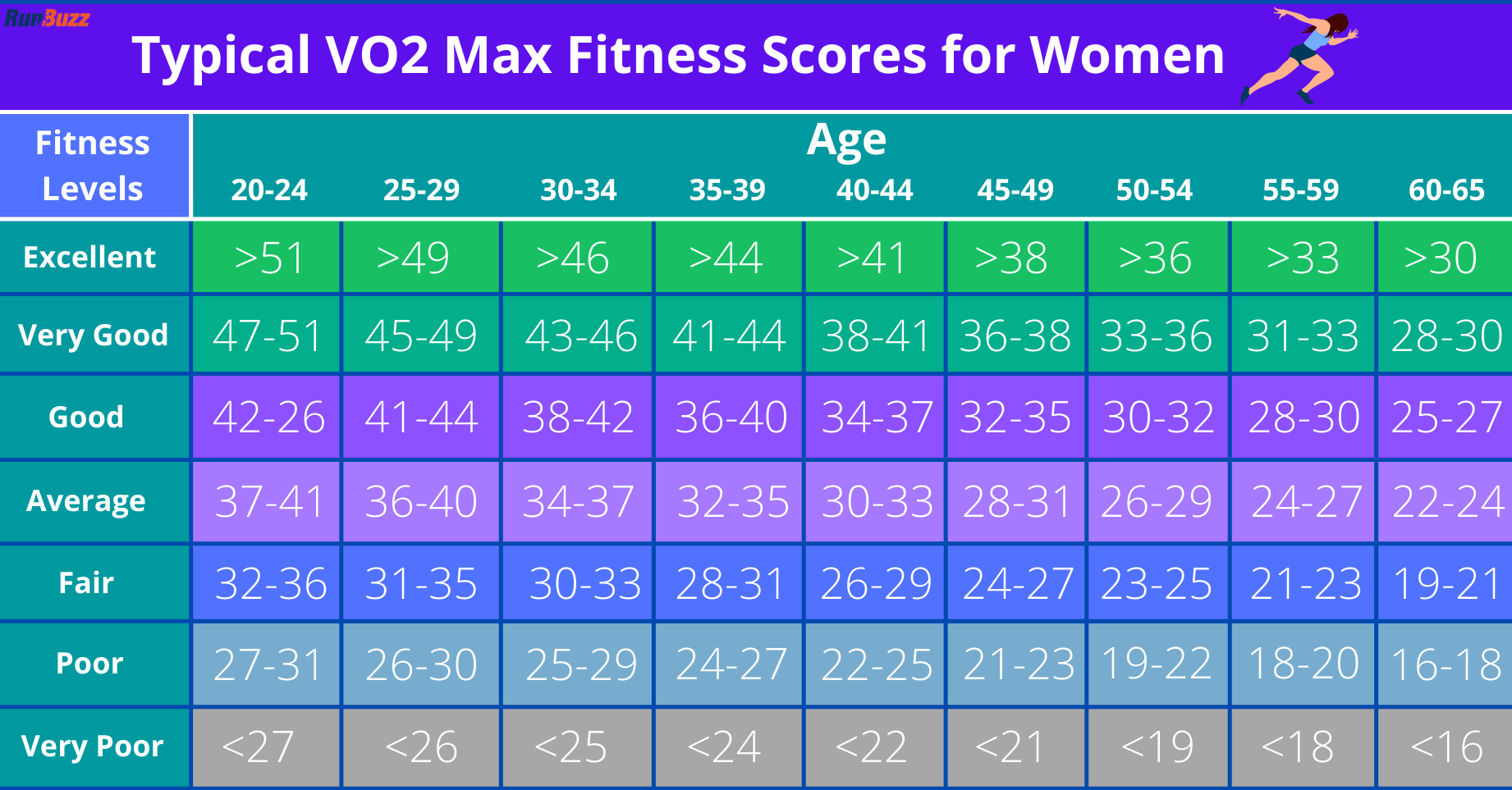
How to Improve Your VO2 Max
Your VO2 Max score will increase automatically as your fitness level improves through training for most recreational runners. After several months, it will stop improving until you focus on more specific workouts.
The best way to improve your VO2 Max is to target your 5k or faster race pace for 12-20 minutes. These can come in a wide variety of exercises which I cover below.
Before digging into the specific types of workouts that target your VO2 Max, keep in mind that the most important thing you can do is establish a strong, running base that includes lots of runs in the “easy-pace” range. You want a strong base before adding more VO2 specific exercises to your training routine.
Once you have a strong base, your body is ready to accept the benefits of VO2 Max-specific workouts.
If you skip this step, your progress will be limited. The “easy-paced” workouts help build capillaries that help compliment the delivery of oxygen to your muscle cells.
Best Run Workouts to Improve Your VO2 Max
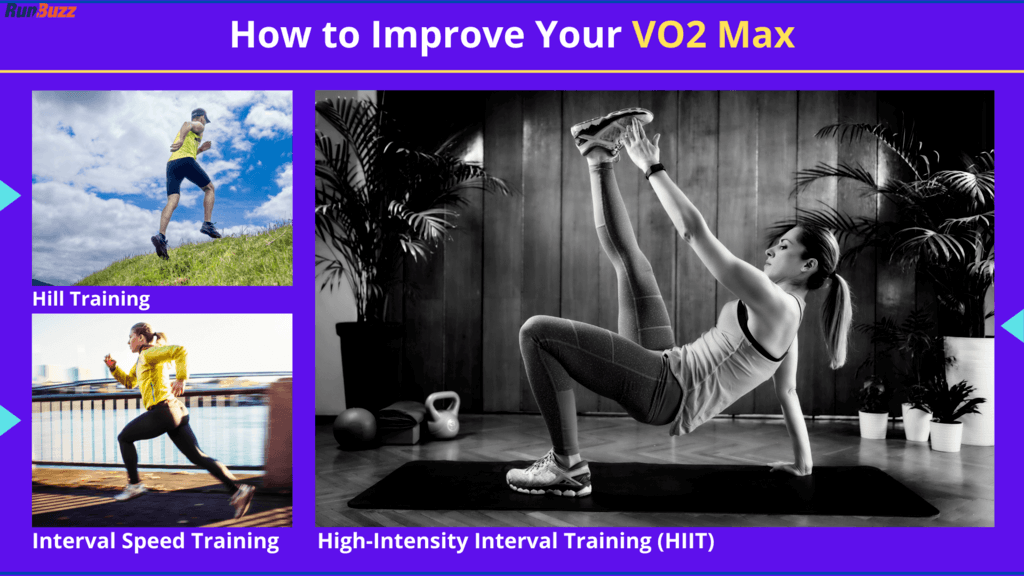
Here are a few ways to improve your VO2 Max:
Hill Training
Hill training is a great way to improve your VO2 Max as well as leg strength and stamina. Start with 3-4 reps (of 2-3 minutes each). If the hill is shorter, then focus on doing hill repeats for up to 12 minutes if you are new to hill training, but no more than 20 minutes. For more information on hill training, check out my Beginner’s Guide To Running Hill Repeats.
Interval Speed Training
Short-distance interval speed training (sometimes known as repeats) is a great way to improve your VO2 Max. Interval speed training is typically conducted on a track or measured route where you repeat certain measured distances. The most common interval distances for VO2 Training are 200 meters, 400 meters, 800 meters, and 1600 meters. Any distance will work as long as you put in a hard effort for 12-20 minutes, not including any recovery breaks. Hard effort is defined as a level of effort where it is difficult to sustain the pace for any long distance or maintain a conversation easily if you were running with a partner.
In between each segment, you may rest or run slowly to recover and prepare for the next segment’s next repeat.
Repeats come in various forms of workouts, so you may come across unique and creative ways to do them. In addition to developing your VO2 Max, they also help with mental/mindset training and improving your leg turnover speed and overall power by helping you develop your fast-twitch muscle fibers, which facilitate faster running,
High-Intensity Interval Training (HIIT)
While not specific to running, HIIT Strength training can improve VO2 max due to its short bouts of high-intensity exercise with a short rest period of 30-60 seconds in between 2-3 minute exercise bursts. The added benefit of HIIT training is that it helps you strengthen your core and overall strength. I personally can attest to the power of adding HIIT training to my overall training program. I have had huge speed gains and no injuries since adding HIIT training to my routine.
- About the Author
- Latest Posts

Steve Carmichael is a running coach, sports performance coach, nutrition coach and has been a recreational runner for over 18 years. Steve holds multiple certifications as a certified running coach through the RRCA and USA Track and Field as well as he is a NASM certified personal trainer, and PN1-L1 certified nutrition coach.
Steve has been coaching since 2010 and has helped thousands of runners online and in the Central Ohio area maximize performance and run injury-free.
Steve is the founder of RunBuzz and Run For Performance.com. If you are interested in working with Steve though his online running and strength coaching services, feel free to reach out.

